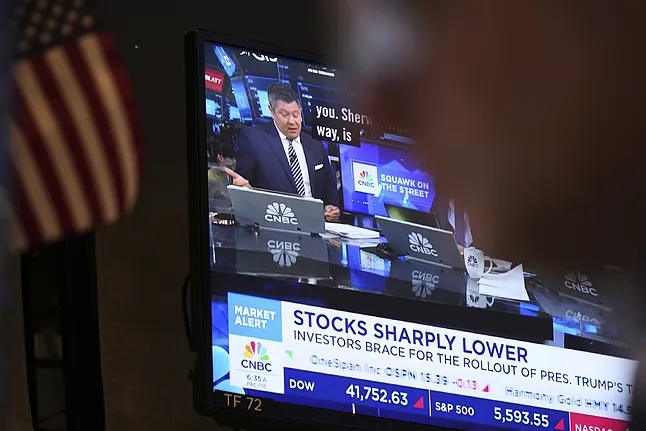The tariffs announced by Donald Trump on Wednesday were much more severe, widespread, and arbitrary than feared. "Worse than the worst-case scenario," according to some market analysts. This led to almost instantaneous reactions in the stock indices, despite the fact that the U.S. President began his intervention at 4:10 p.m. Washington time, not coincidentally with Wall Street already closed.
The shock is noticeable worldwide, resulting in a shift to red in futures and after-hours trading. This led to brutal losses in the stock exchanges of some of the countries most affected by the trade retaliation, from Japan and South Korea to Vietnam, which at 11:32 local time (6:30 a.m. in Spain) was down 6% of its value.
The stock market day ended in green on Wednesday despite the imminent announcement, or perhaps because of it, in a last session before the storm. However, after Trump's announcement, futures for the three reference indices dropped by 2.5%, which are used by various indexed funds (ETFs) in the hours following the closing:
The futures for the industrial benchmark, the Dow Jones, fell by 1.9%, or more than 800 points, while those of the Nasdaq, which includes technology companies, dropped by 3.3%. The S&P 500 futures, the largest, fell by another 2.8%.
By around 5:35 p.m. ET (9:35 p.m. GMT), investors punished technology companies such as Apple (-5.5%), Amazon (-4.5%), Meta (-3.8%), Tesla (-4.3%), and Nvidia (-3.7%); motor companies like General Motors (-2.5%) and Stellantis (-1.8%), or financial institutions like Citigroup (-2.5%) and JPMorgan (-2.4%).
Trump's tariff plan, which has kept markets on edge in recent weeks, implies a minimum global tariff of 10%. 20% for Europe, a total of 54% for China, and nearly 50% for many of the main Asian producers.
The Nikkei index in Japan fell more than 3.0% at its opening on Thursday, dragged down by automakers' stocks, as specific tariffs for vehicles not made in the U.S. begin to be applied starting today.In South Korea, the Kospi benchmark index dropped by 2.2%, with some recovery, due to the decline in semiconductor stocks (although they are currently exempt), batteries, and automobiles.
Australian stocks were also affected, despite the country relatively escaping Trump's so-called "reciprocal discounted tariffs," according to The Wall Street Journal. The benchmark index dropped by 1.9%, heading towards its biggest daily loss since September. Personal protective equipment manufacturer Ansell led the declines, with a 13% drop after the U.S. announced tariffs of up to 44% on Malaysia, Thailand, and Sri Lanka. Ansell has production plants in all three countries, as reported by Efe.
The minimum global tariff of 10% will take effect on Saturday, and what Trump calls "reciprocal" will start on April 9. Although the calculation used by the administration makes no sense and does not reflect any trade barriers or restrictions, as falsely claimed by Trump, Asian countries have the highest rates, as they have the most pronounced trade deficits. This is the case for Vietnam (46%), where many fashion companies source their supplies, explaining declines in firms like Nike (-7%) or Deckers (-10%), which sells footwear brands like Ugg and Hoka, as reported by specialized media.
The reaction to the tariffs was also felt in other asset markets considered safe havens, such as gold, which rose by almost 4%, to $3,190 per ounce. The 10-year Treasury bond yield dropped to 4.127%; Conversely, Texas oil fell to $10.73 per barrel, and Bitcoin dropped to $84,647.
